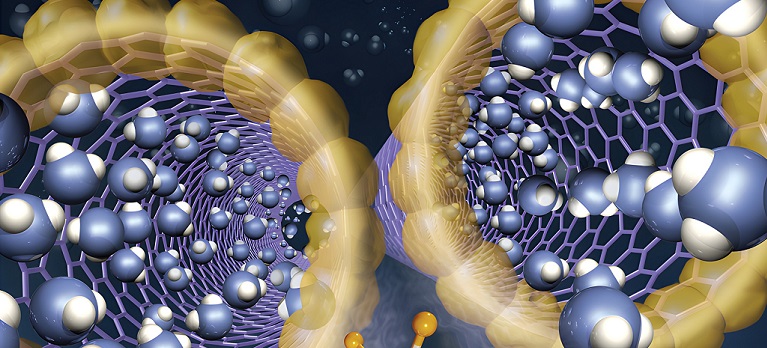

- HOME
- Research
- Carbon Nanotube Nanofluidics
Carbon Nanotube Nanofluidics
Carbon Nanotube Nanofluidics for Energy Technology and Sustainability
This program will focus on understanding of fundamentals of mass transport through carbon nanotubes and application of thus acquired basic nanoscience to energy technologies for addressing our future sustainability. Previous experimental study [1] of the molecular transport through the internal space of CNT demonstrated enhanced flows of water under extreme (sub-2-nm) one-dimensional confinement by atomic-scale smooth, hydrophobic surfaces. Through a hierarchical micro/nanomanufacturing technique, the study also developed a prototype membrane with CNTs serving as pores. Those findings, together with a recent demonstration of ion exclusion by the CNT-membrane [2], are shedding light on the capability of energy-efficient filtration by CNT-membranes.
Much more to learn:
current state of understanding of the basics of transport in CNTs still lies on its adolescence stage. There are much more science to uncover that could potentially nurture new fields of applications. The fundamental science domain of this program will, therefore, center on broadening the basic knowledge of CNT nanofluidics and expand it toward noncontinuum fluid dynamics and mass transfer at nanoscale.Energy technology for sustainability:
it is predicted that the 21st century society and economy will place enormous demands for clean water and energy supply. CNT-membrane has many potential advantages to address those demands. First, as previous research has demonstrated, chemically functionalized CNT-membrane can exclude ions in an aqueous solution through reverse osmosis. Second, water flows in CNTs can experience less than 1000 times of viscous drag compared to other reverse osmosis membranes. Thirdly, if ionic solutions are driven by electrokinetic potential, very interesting phenomena may occur related to the equilibrium conformation of ions under extreme confinement. Fourthly, it is possible to functionalize the surface of the CNT membrane in a variety of fashion for other purposes such as solar energy harvesting and drug delivery for on-demand cure. These potentials pose a wide range of applications in energy technology from sea water desalination and water decontamination to next generation fuel cells to solar energy harvesting. Prof. Park’s research program requires a series of interrelated, coordinated and synergistic research topics outlined as follows:




